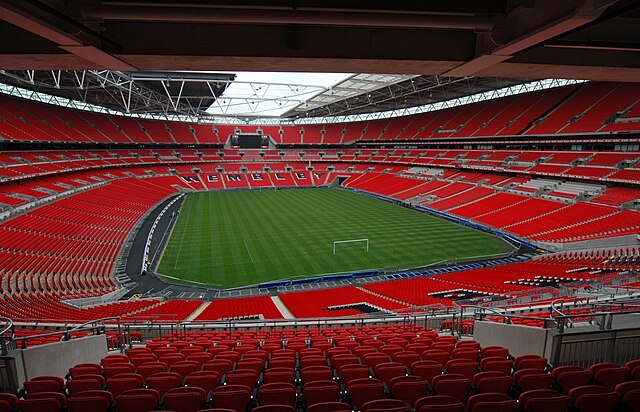The Bobby Moore statue is a bronze sculpture of the former West Ham and England footballer Bobby Moore, situated directly outside England's national stadium, Wembley Stadium, in Wembley Park, north-west London. It commemorates the life of Moore, who captained the only England side ever to win the World Cup, defeating Germany 4–2 in the 1966 FIFA World Cup Final held in England at the old Wembley Stadium, demolished in 2003. Commissioned by the Football Association, it was unveiled outside the new stadium when it opened in 2007, fourteen years after Moore's death from cancer, aged 51. Standing 20 feet (6.1 m) tall on a stone plinth, it looks out over spectators as they walk down Wembley Way into the stadium. Sculpted by the Royal Sculptor Philip Jackson, it is Jackson's second piece featuring Moore, after the World Cup Sculpture unveiled in 2003.
The sculpture in 2008
The full statue and plinth, outside the Wembley north entrance
The statue at the end of Wembley Way
By night, beneath the Wembley Arch
Wembley Stadium is an association football stadium in Wembley, London. It opened in 2007 on the site of the original Wembley Stadium, which had stood from 1923 until 2003. The stadium is England's national football stadium, and thus hosts the majority of the England national football team home matches and the FA Cup Final – the final of England's primary domestic club football competition. It is widely regarded as one of the most iconic football stadiums in the world, and is considered a hub for the English game. Wembley Stadium is owned by the governing body of English football, the Football Association, whose headquarters are in the stadium, through its subsidiary Wembley National Stadium Ltd (WNSL). With 90,000 seats, it is the largest stadium in the UK and the second-largest stadium in Europe.
Wembley Stadium in 2022
Wembley Stadium interior
Wembley illuminated
The stadium in its very early stages of construction c. August 2003








